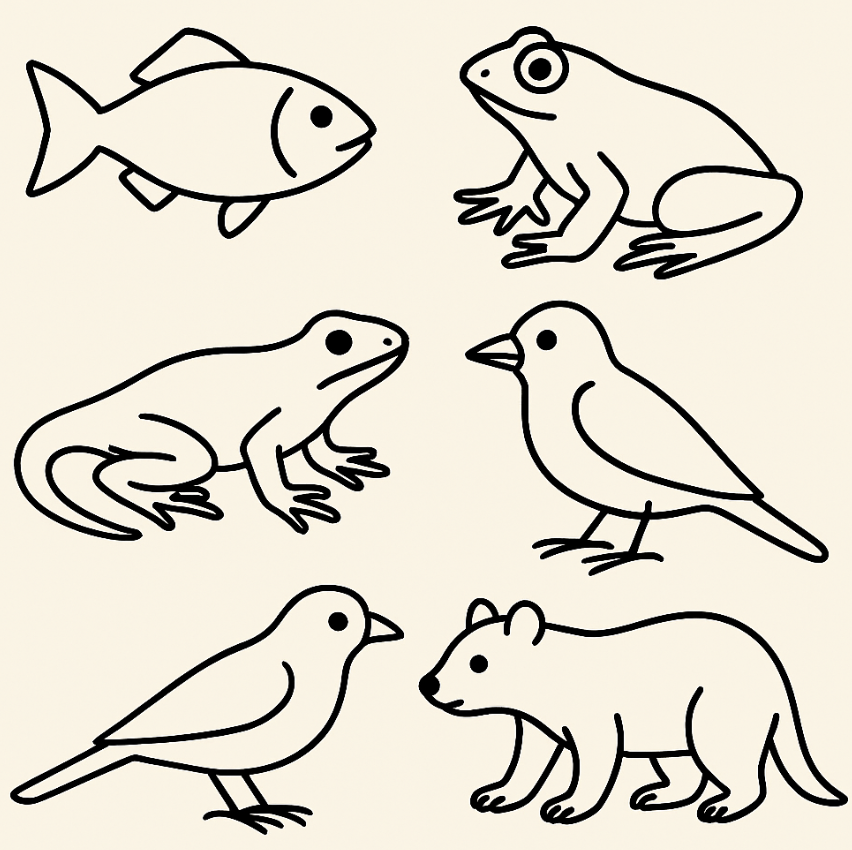목차
The diversity of bird species is one of the most remarkable aspects of the vertebrate world. Birds are found in nearly every environment on Earth—from arid deserts to polar ice caps, dense rainforests to open oceans. But how does avian species richness compare with other major vertebrate groups such as mammals, amphibians, reptiles, and fishes? In this article, we analyze and compare the species diversity across vertebrate classes, highlighting the ecological roles and evolutionary adaptations that have shaped these numbers.

Overview of Global Vertebrate Species Diversity
To compare species diversity meaningfully, we look at the total number of described species within each major group of vertebrates:
| Vertebrate Group | Approximate Number of Described Species |
| Fish | ~34,000+ |
| Birds | ~11,000+ |
| Reptiles | ~11,000+ |
| Amphibians | ~8,000+ |
| Mammals | ~6,600+ |
As of the most recent global assessments (based on data from IUCN, BirdLife International, and various taxonomic databases), birds rank as the second most species-rich group of terrestrial vertebrates, following fish, which dominate due to their immense diversity in aquatic habitats.
Bird Species Diversity in Context
1. Birds vs. Mammals
- Birds: ~11,000 species
- Mammals: ~6,600 species
Birds nearly double the number of described mammal species. While mammals vary greatly in size and ecological function, birds have a much wider global distribution and occupy a broader array of ecological niches. Birds are also capable of powered flight, which has contributed significantly to their speciation through isolation and adaptive radiation.
For example:
- Birds have colonized remote islands where mammals are often absent.
- They exploit aerial niches (e.g., swifts, albatrosses) that mammals cannot.
- Birds undergo long-distance migrations, increasing gene flow and population fragmentation that encourages speciation.
2. Birds vs. Amphibians
- Birds: ~11,000 species
- Amphibians: ~8,000 species
Though amphibians show impressive diversity, especially in tropical rainforests, their diversity is limited by several factors:
- Amphibians are highly moisture-dependent, restricting them primarily to wet, humid environments.
- Their permeable skin makes them vulnerable to environmental changes and pollution, reducing their adaptability.
- In contrast, birds are highly adaptable and found from the Arctic tundra to equatorial rainforests and even deserts.
Birds exhibit greater ecological versatility, enabling them to diversify more widely across global ecosystems.
3. Birds vs. Reptiles
- Birds: ~11,000 species
- Reptiles: ~11,000 species (closely matched)
Birds and reptiles are evolutionarily connected, with birds actually being considered a branch of the dinosaur lineage within the class Reptilia. Although reptiles and birds have nearly equal species counts, their ecological roles differ drastically.
- Reptiles are mostly ectothermic (cold-blooded), limiting their activity and range.
- Birds are endothermic (warm-blooded), allowing greater activity levels and colonization of colder climates.
- Birds have evolved complex social behaviors, vocal communication, and reproductive strategies, further aiding diversification.
4. Birds vs. Fish
- Birds: ~11,000 species
- Fish: ~34,000+ species
Fish represent the most diverse vertebrate group by far, primarily due to the vastness of aquatic habitats and the evolutionary age of fishes (over 500 million years). The oceans, rivers, and lakes host an enormous array of species with highly specialized adaptations.
However, when considering only terrestrial vertebrates, birds lead in species richness.
Reasons Behind High Bird Species Diversity
Several key factors contribute to the success and diversity of birds:
A. Flight and Mobility
Flight gives birds unmatched mobility, allowing them to:
- Escape predators
- Disperse over long distances
- Explore and colonize new habitats
- Avoid geographic barriers that restrict other animals
B. Adaptive Radiation
Birds have undergone massive adaptive radiations. A prime example is Darwin’s finches in the Galápagos Islands, where a single ancestral species gave rise to multiple species with different beak shapes and feeding behaviors.
C. Specialized Ecological Niches
Birds occupy nearly every ecological role:
- Predators (hawks, owls)
- Scavengers (vultures)
- Seed dispersers (fruit-eating birds)
- Pollinators (hummingbirds)
- Insect controllers (flycatchers)
This ecological diversity supports speciation and coexistence.
D. Complex Behavior and Vocal Communication
Birds often have elaborate courtship rituals, territorial calls, and social structures that enhance reproductive isolation, a key driver of speciation.
Conservation Implications of Bird Diversity
Birds, due to their diversity and widespread distribution, serve as excellent bioindicators of ecosystem health.
However, despite their high diversity, birds face numerous threats:
- Habitat destruction
- Climate change
- Invasive species
- Pollution
According to IUCN, over 1,400 bird species are currently threatened, including many endemic and migratory species.
Maintaining bird diversity is crucial, as they play irreplaceable roles in ecosystems, such as:
- Pest control
- Pollination
- Seed dispersal
- Scavenging and nutrient cycling
Conclusion
In comparison to other vertebrate groups, birds stand out as one of the most diverse and ecologically significant classes. With over 11,000 species, birds surpass mammals and amphibians in species richness and rival reptiles in global count. Their unique ability to fly, broad ecological roles, and evolutionary adaptability have allowed them to flourish in virtually every environment on Earth.
As the planet continues to change, preserving the incredible diversity of birds is not only a matter of species conservation but a critical component of maintaining ecological balance.